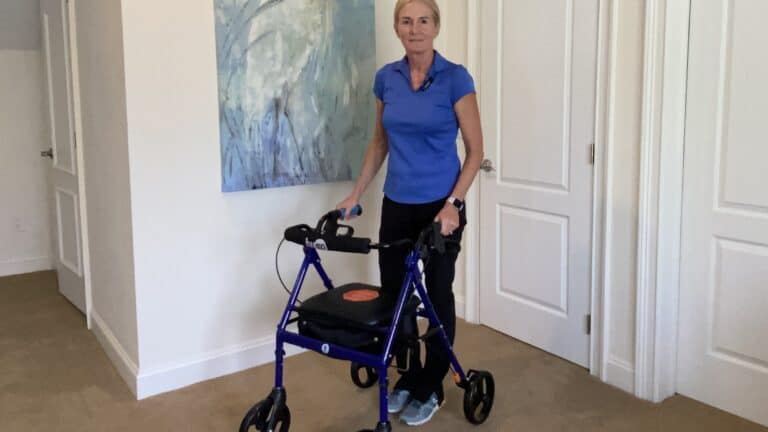4 Powerful Benefits of Exercise for People with Dementia
Most of us understand the importance of physical exercise – daily movement- to our health and well-being.
But often individuals with dementia -especially moderate to later stages- remain seated in front of the television or reclined in bed for many hours on end.
As caregivers we may try to get them up and about but tire of the constant nagging and refusals. In this post, I’ll cover the benefits of regular exercise for individuals with dementia.
This falls under the A or activities pillar of my CARES framework for working with individuals with dementia.
Does Exercise Help People with Dementia?
Research shows that regular exercise offers numerous benefits for individuals with dementia. Benefits include improved cognition, mood, physical function, appetite, sleep, and quality of life (Faulk et al., 2014; Song & Yu, 2019) .
4 Benefits of Exercise for Individuals with Dementia
Improved Cognition
Exercise improves blood flow and oxygenation of the brain. This is important for brain health and function.
Mood
Regulation
Exercise has been shown to improve symptoms of depression and support improved mental outlook.
Physical Function
Exercise can improve an individual’s ability to perform daily activities like dresing, bathing, and toileting.
Better
Sleep
Regular exercise improves sleep quality which is important for brain health.
Exercise has been shown to promote the production of chemicals in the brain that aid in the growth of new neurons, which can help combat the cognitive decline associated with dementia.
Additionally, physical activity stimulates blood flow and oxygenation to the brain, fostering neuroplasticity and enhancing brain function.
So what is meant by regular exercise? Are we talking about exercise classes or videos? do we need to go to the gym? What if your person with dementia has mobility problems, pain, or has never been a fan of exercise?
Exercise can look different for everyone. The important thing is to keep moving – regular movement improves strength and coordination, enhances mood and outlook, supports good sleep and appetite, and contributes to cognitive abilities such as memory and attention (focus).
Start with activities that connect your LO with their past: what was their favorite sport? Did they have any hobbies?
It doesn’t matter if they cannot do the activity in its entirety or even in the same manner that they used to – virtually anything can be adapted. The important thing is that it will connect them to their past and be more engaging than some newly introduced activity.
What are the Best Exercises for Individuals with Dementia?
When designing an exercise program for someone with dementia, it is valuable to consider their past activity interests and incorporate them into their current routine.

By doing so, you can tap into their personal history and preferences, making the exercise more enjoyable and engaging for them.
Strategies to target exercise and movement to a person’s past activity interests
Identify Past Athletic or Sporting Interests
Explore the individual’s past to uncover any sports or athletic activities they enjoyed. If they were a competitive athlete in high school or college, try to find elements of their preferred sport that can be adapted to their current abilities.
Modify Activities
Adapt activities to accommodate any mobility problems or physical limitations your loved one may have. If they have difficulty walking, consider seated exercises or low-impact activities. Modify movements to ensure safety and comfort, focusing on maintaining strength, flexibility, and coordination.
Use Memory-Triggering Props
Incorporate props or equipment that remind the individual of their past activities. For example, if they were a golfer, provide a putter and a small putting mat to practice their putting skills indoors. The familiar equipment can evoke positive memories and increase engagement in the exercise.
Emphasize Enjoyment and Social Interaction
Make exercise a pleasurable experience by integrating social elements. Invite friends or family members to participate in activities together. This can foster a sense of camaraderie, motivation, and emotional well-being.
Explore Leisure Activities
Consider incorporating leisure activities that align with the person’s interests and abilities. This could include gardening, gentle nature walks, or even simple crafts. These activities promote movement and engagement while tapping into their personal preferences.

Keep it Simple and Accessible
Exercise does not necessarily mean going to a gym or following complex routines.
Focus on incorporating movement into daily activities
Encourage household chores, such as light cleaning, gardening, or dancing while cooking.
Simple exercises like stretching, seated movements, or even taking a short walk can provide significant benefits.
It is important to note that exercise programs for individuals with dementia should be personalized and take into account their current abilities, mobility problems, pain, and their personal history with exercise.
Consult with healthcare professionals, such as physical therapists or occupational therapists, to develop a safe and tailored exercise plan that considers these factors.
Remember, the goal is to promote movement, engagement, and enjoyment.
By connecting exercise and movement to a person’s past activity interests, you can enhance their motivation, maintain their physical function, and positively impact their overall well-being.
Citations
Faulk, S. & Edwards, L. & Sumrall, K. & Shelton, T. & Esalomi, T. & Payton, C. & Wooten, C. & Dolbow, David. (2014). Benefits of physical activity on Alzheimer’s disease: A literature review. Clinical Kinesiology. 68. 19-24.
Song D, Yu DSF (2019). Effects of a moderate-intensity aerobic exercise programme on the cognitive function and quality of life of community-dwelling elderly people with mild cognitive impairment: A randomised controlled trial. International Journal of Nursing Studies. May;93:97-105. doi: 10.1016/j.ijnurstu.2019.02.019. Epub 2019 Mar 5. PMID: 30901716.






